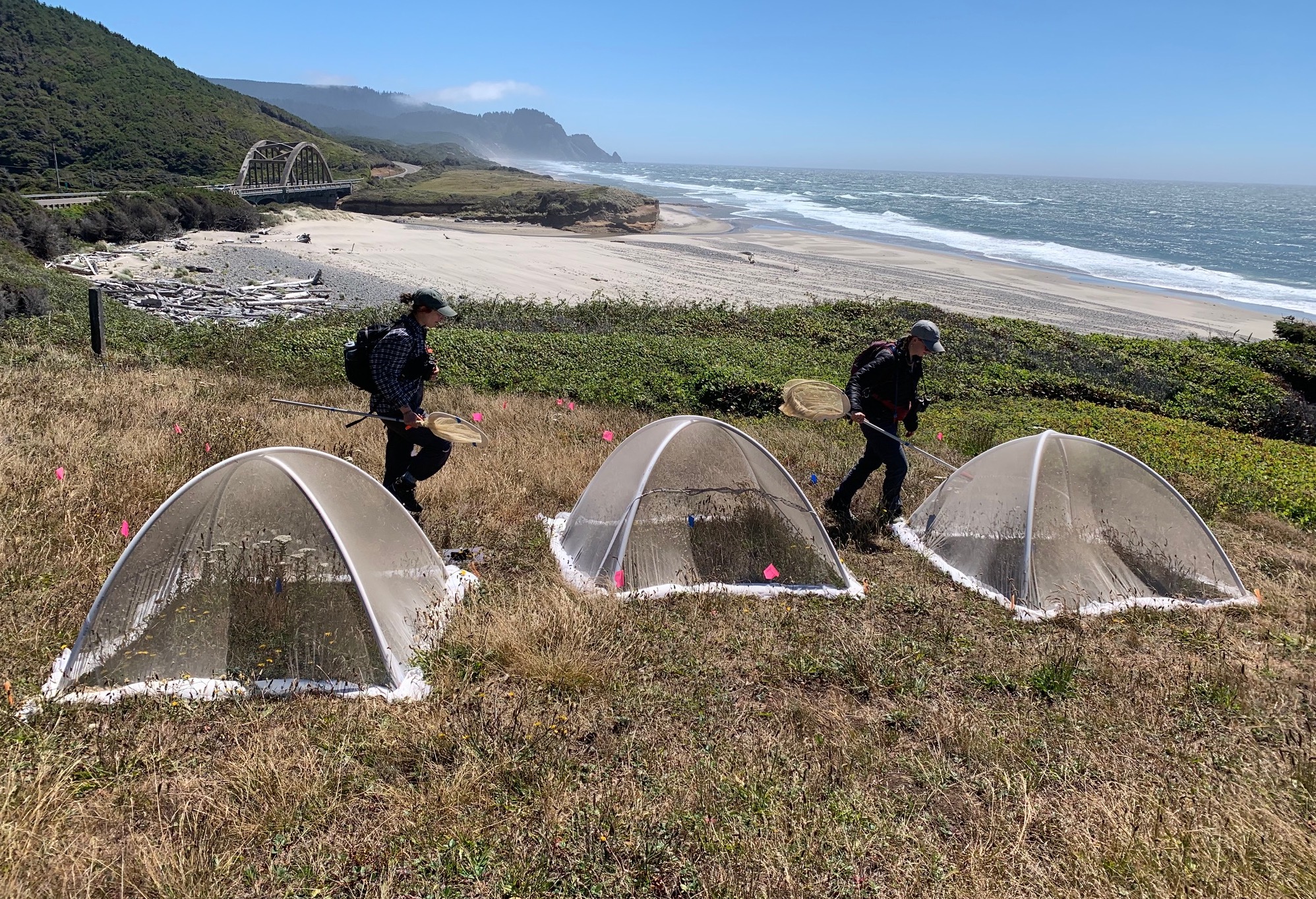
By GARRET JAROS/YachatsNews
Izzy Bur kneels on the ground to avoid the brunt of a howling wind that rakes across the salt-spray meadow overlooking the ocean south of Rock Creek.
With the fingers of one hand gently grasping the gossamer wings of a butterfly she uses the other to write a number across the tops of its wings, first in black Sharpie then again with a silvery glitter pen.
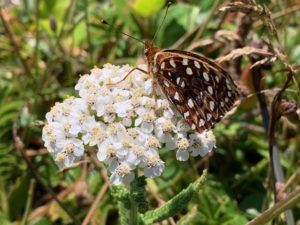
“With binoculars the glitter stands out better,” explained Bur, one of several field researchers who continue this summer the decades-long effort to bring the Oregon silverspot butterfly back from the brink of extinction.
“We call them butterfly tattoos,” Bur’s research partner Emma Dombrow added as the freshly-inked silverspot showed no interest in leaving Bur’s hand to brave the wind. “Sometimes they fly off and sometimes they stay on your hand a bit.”
“When it’s super windy like this, we try to release them low and then they will fly off when they are ready,” Burr said.
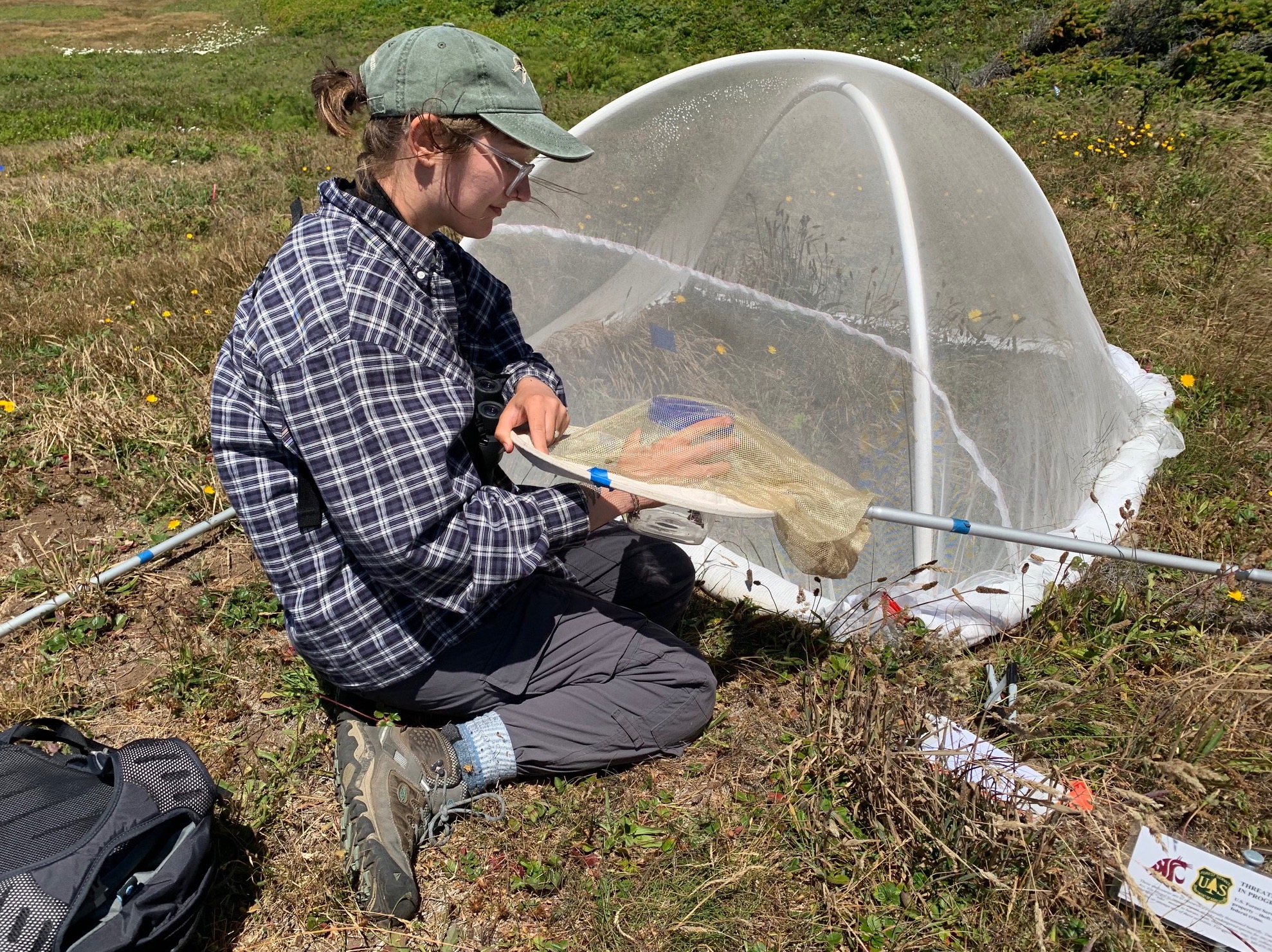
Threatened since 1980
The Oregon silverspot once inhabited coastal meadows from southern Washington to northern California. It was placed on the federal threatened species list in 1980 but its numbers and range continue to decline. Today the butterfly holds on in just five places in Oregon and one near Lake Earl in Del Norte County, California.
Researchers with the U.S. Forest Service and the U.S Fish & Wildlife Service have been leading recovery efforts through habitat restoration and reintroduction thanks to silverspot caterpillar breeding programs at the Oregon Zoo in Portland and the Woodland Park Zoo in Seattle.

Assisting in recovery are soil and water districts that plant species the butterfly pollinate and feed upon. Several universities are also helping in a number of ways, including providing field researchers like Bur and Dombrow, who are graduate students at Washington State University.
At the epicenter of Oregon silverspot survival is a single host plant – the early blue violet. The small plant is the only flower on which the butterfly larvae can successfully feed and develop. And they are the reason for the small mesh tents passersby see pitched across the meadow at Rock Creek.
Bur and Dombrow are focused this summer on “mark, release, recapture” to more accurately determine population and distances traveled. And to study what effect if any ongoing landscape management practices such as mowing and burning are having on reclaiming violet habitat lost over time to encroaching grasses and trees from decades of fire suppression.
In June, researchers placed seven zoo-raised caterpillars atop violets inside each of the 24 tents at Rock Creek, 30 at Mount Hebo and 54 at Nestucca Bay National Wildlife Refuge – where the silverspots were re-introduced. The first butterflies began emerging from tents in early July resulting in 21 by mid-month.
Hatching seven butterflies per tent would be a “dream scenario,” Bur said.
Brays Point just north of Tenmile and Cascade Head in north Lincoln County are the two other sites where Oregon silverspots still exist.
“We’ve had four come out of this tent this year, which is really exciting,” Bur said as she reached inside to collect another butterfly. “It shows a good survival rate. This year seems like a better butterfly year than last year. I’m not sure why. It was a cold, wet spring last year. That may have affected them.”
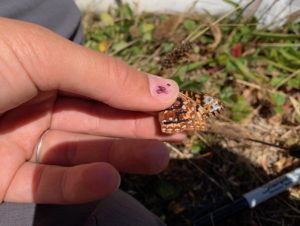
Touching a butterfly’s scale-covered wings does not hamper their ability to fly, Bur explained as she marked the amber and black outer wings while leaving the inner wings with their distinctive silver spots untouched.
“The scales fall off as they age,” Bur said. “If the wings are more translucent you can tell they are older. When they are young, like this one, the wings are vibrant and bright.”
No sooner had Bur finished marking the second butterfly than it ascended into the rushing tide of wind – its kite-like wings fluttering in the erratic manner all butterfly species have adapted to avoid predators – and is instantly swept away.
“It’s incredible how they can fly when it’s windy like this,” Dombrow said. “We think they just came out today because of their super-fresh color and they were very energetic in the tents.”
“It’s amazing they survive,” Bur added.

Butterfly warnings
Siuslaw National Forest head biologist Deanna Williams, who is on the front line of silverspot recovery, has described the butterflies place on the coastal landscape as akin to a canary in a coal mine. Any die-offs are a warning something toxic is happening in the environment and could portend the extinction of a myriad of other species dependent on the same habitat.
“It’s a system thing,” Williams told the YachatsNews in 2021. “The silverspot has been telling us that the coastal systems are struggling. We have to understand all the pieces so we can help save the larger system.”
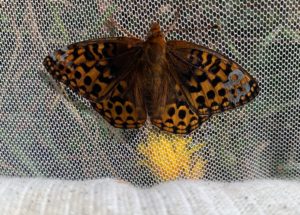
Oregon silverspot live out their life cycle in unique wind-blown salt-spray coastal meadows and contribute to pollinating a host of wildflowers from the sea to nearby forests. Butterflies emerge in late June and into July. They mate and lay 200 or so eggs the size of sesame seeds near blue violets in August.
“The butterflies can live four to six weeks, which is a really long time for a butterfly,” Bur said.
Larvae hatch about 16 days after being laid and go into “diapause” which is insect hibernation. And then in spring when the violets emerge, the larvae wake up and become active.
Last year, Williams said some of the questions researchers are trying to answer is – how far silverspots travel upon emergence (four miles is the farthest recorded so far); how larvae respond to hot and dry conditions; whether more butterflies continue to come out of meadows that have been closely cropped; and where wild females go after they emerge.

“Unfortunately, we rarely receive answers quickly in natural resource studies,” Williams said in an interview this month. “There are so many variables that it takes time and careful attention to determine how all the pieces are influencing each other, but we are gathering some great data that is adding to our understanding each year.”
While biologists know that Oregon silverspots number in the thousands, they also note that populations fluctuate from year to year, which is one reason the annual field studies are needed as habitat is impacted by climate and management.
“I think we are starting to confirm that a wide variety of habitat microclimates are an important part of providing the silverspot with the means to respond to not only yearly fluctuations in weather but also changes to overall climate,” Williams said.
- Garret Jaros is YachatsNews’ full-time reporter and can be reached at GJaros@YachatsNews.com




















